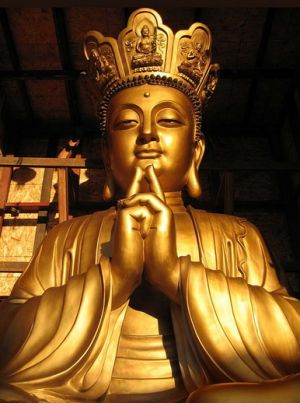Difference between revisions of "Youthful vase body"
Jump to navigation
Jump to search
m (1 revision: ADMINOS 11 october) |
|||
| Line 1: | Line 1: | ||
| + | [[File:4572 53 z.jpg|thumb]] | ||
'''Youthful vase body''' (Wyl. ''[[gzhon nu bum pa'i sku]]'', Tib. ''[[shönnu bum pai ku]]'') — a common metaphor in the [[Dzogchen]] teachings is that of a youthful image or '[[body]]' enclosed within a vase. This signifies the [[dharmakaya]] in which all qualities are present but not visible from the outside. The body is described as youthful to indicate that these qualities are [[pure]] and pristine, untainted by [[samsara]], and immune from [[birth]] and [[death]]. | '''Youthful vase body''' (Wyl. ''[[gzhon nu bum pa'i sku]]'', Tib. ''[[shönnu bum pai ku]]'') — a common metaphor in the [[Dzogchen]] teachings is that of a youthful image or '[[body]]' enclosed within a vase. This signifies the [[dharmakaya]] in which all qualities are present but not visible from the outside. The body is described as youthful to indicate that these qualities are [[pure]] and pristine, untainted by [[samsara]], and immune from [[birth]] and [[death]]. | ||
==Alternative Translations== | ==Alternative Translations== | ||
| + | |||
*[[Youthful body in a vase]] (David Germano) | *[[Youthful body in a vase]] (David Germano) | ||
==Further Reading== | ==Further Reading== | ||
| + | |||
*Dudjom Lingpa, ''Buddhahood Without Meditation'', translated by [[Richard Barron]] (Padma Publishing, 1994, revised edition 2002), page 149 (contains [[Ekajati]]'s explanation to [[Dudjom Lingpa]]). | *Dudjom Lingpa, ''Buddhahood Without Meditation'', translated by [[Richard Barron]] (Padma Publishing, 1994, revised edition 2002), page 149 (contains [[Ekajati]]'s explanation to [[Dudjom Lingpa]]). | ||
Latest revision as of 04:49, 22 December 2020
Youthful vase body (Wyl. gzhon nu bum pa'i sku, Tib. shönnu bum pai ku) — a common metaphor in the Dzogchen teachings is that of a youthful image or 'body' enclosed within a vase. This signifies the dharmakaya in which all qualities are present but not visible from the outside. The body is described as youthful to indicate that these qualities are pure and pristine, untainted by samsara, and immune from birth and death.
Alternative Translations
- Youthful body in a vase (David Germano)
Further Reading
- Dudjom Lingpa, Buddhahood Without Meditation, translated by Richard Barron (Padma Publishing, 1994, revised edition 2002), page 149 (contains Ekajati's explanation to Dudjom Lingpa).
